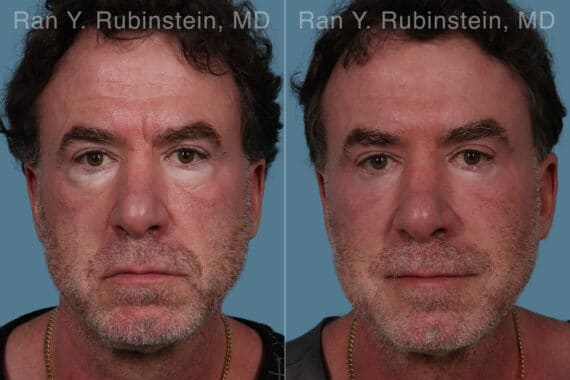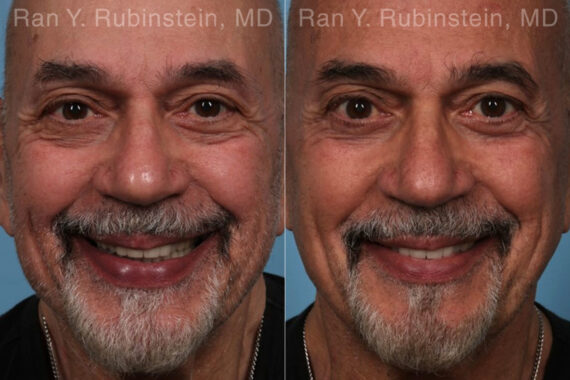Facial fat transfer is a popular option for restoring volume and achieving a more youthful appearance. Many women considering this treatment often ask the same question—are the results permanent, or will the fat eventually go away? The answer isn’t the same for everyone, but there are clear patterns that can help you understand what to expect.
With years of experience in facial procedures, Dr. Ran Rubinstein provides expert guidance on how long facial fat transfer results typically last and what can affect their staying power.

How Fat Transfer Restores Facial Volume Using Your Own Fat
- Fat transfer results can be long-lasting. While some fat is reabsorbed in the first six months, the fat cells that survive become a lasting part of your facial structure.
- The success of facial fat grafting depends on several factors. Your body’s healing process, the surgeon’s technique, and your lifestyle all play a role in how much fat survives and how long your results last.
- Facial fat transfer offers a natural solution to facial volume loss. Because the procedure uses your own fat instead of synthetic fillers, results often look and feel more natural, especially in areas like the cheeks and under eyes.
- Compared to dermal fillers, fat grafting offers longer-lasting results. Fillers typically last several months, while fat transfer can offer results that last for years—or even longer—with proper care.
How Long Facial Fat Transfer Results Typically Last

One of the most common questions patients ask is: “How long does facial fat transfer last?” The short answer is that results can be long-lasting—often several years or more—but not all of the transferred fat will survive the initial healing period.
After the fat is injected into the face, your body must create a new blood supply to keep those fat cells alive. Some of the fat—usually about 30% to 50%—is naturally absorbed by the body in the first six months. The remaining fat cells that do survive this period are typically long lasting. With the natural aging process we continue to lose fat cells. Patients may benefit from touch up procedures every 5 to 10 years.
For many patients, the final results of facial fat grafting can last five years or longer, depending on factors like age, skin quality, and lifestyle. In some cases, results may even last a decade or more, making this a more enduring option than many dermal fillers.
What Affects the Longevity of Facial Fat Transfer Results
While fat transfer surgery is designed to produce lasting improvement, how long your results will last depends on a combination of biological, surgical, and lifestyle factors. Understanding what influences fat survival and grafting outcomes can help you set realistic expectations.
The Role of Your Body’s Natural Healing Process
Once fat is injected into the face, your body begins a healing process that determines how much of the fat will “take”—in other words, how much fat will successfully establish itself and remain long term. This process is unpredictable to some extent and varies from patient to patient.
Factors like blood supply, inflammation, and the condition of your skin and tissues all affect the success of the fat grafting procedure. Younger patients with healthy skin and good circulation may retain more fat. Those with underlying medical conditions, a history of smoking, or poor skin elasticity may have less predictable outcomes.
How Surgeon Technique Can Impact Long-Term Results
The expertise and technique of your facial plastic surgeon play a significant role in the longevity of facial fat transfer results. Dr. Rubinstein uses advanced micrografting techniques that allow for precise placement of small amounts of fat in multiple layers of tissue. This approach maximizes contact between the grafted fat and surrounding blood vessels, increasing the likelihood of long-term survival.
Additionally, fat must be harvested, purified, and injected carefully to preserve the integrity of the fat cells. Too much fat in one area can lead to clumping or fat necrosis, while too little may not achieve the desired volume. Working with an experienced facial plastic surgeon is essential for achieving balanced, natural, and lasting results.
Lifestyle Habits That Influence Fat Survival
How you care for yourself after surgery can influence your outcome. To help the transferred fat cells survive and integrate successfully into your facial tissues, patients should:
- Avoid smoking, which can constrict blood vessels and reduce fat survival
- Maintain a stable weight—significant weight fluctuations can cause the fat to shrink or enlarge
- Avoid strenuous exercise for the first few weeks while healing
- Follow all aftercare instructions from Dr. Rubinstein closely
Long-term lifestyle choices, such as sun protection and a healthy diet, can also help maintain your skin quality and support lasting facial fat transfer benefits.
Start Your Journey to Success, Don’t Wait More!
Join our satisfied clients who’ve experienced safe, effective treatments.
Facial Fat Transfer vs Fillers: Which One Lasts Longer?
Facial fat grafting is often compared to dermal fillers because both aim to restore lost volume and smooth wrinkles. However, there are significant differences in how long each treatment lasts—and in how each one works.
Patient Results
* All patients are unique and individual results may vary.
Key Differences in Duration and Results
Dermal fillers, such as hyaluronic acid-based products, typically last 6 to 24 months depending on the area treated and the type of filler used. Over time, the body gradually breaks down these fillers, requiring repeat injections to maintain results.
Facial fat injections, on the other hand, use your body’s own living tissue. Once the transferred fat has integrated into the face, it can remain there permanently. Although some fat may be lost early on, the surviving fat cells remain and can age naturally with you.
This makes facial fat grafting a more permanent alternative for those looking for longer-lasting facial rejuvenation—particularly in areas like the cheeks or temples, where loss of facial volume contributes significantly to an aged appearance.
Why Some Patients Choose One Over the Other
While the longevity of facial fat transfer is a major advantage, it’s not necessarily the right choice for everyone. Here are a few reasons patients might choose one option over the other:
Facial Fat Transfer may be ideal for:
- Patients looking for natural-feeling volume
- Patients seeking a more permanent solution
- Those undergoing other procedures like facelift surgery or brow lift
- Individuals with enough fat available for harvesting
Dermal Fillers may be better for:
- Patients who don’t have enough fat for grafting
- Patients seeking quick results with minimal downtime
- Those hesitant about surgery or recovery
- Individuals unsure about committing to permanent volume changes
Dr. Rubinstein often helps patients weigh the pros and cons of each approach during consultation. In some cases, a combination of both treatments may be recommended for best results.
Help Your Facial Fat Transfer Last Longer
Even though a portion of fat may be reabsorbed by the body, there are several ways to help improve the longevity of your fat transfer results.
To help your facial fat grafting procedure succeed, Dr. Rubinstein may advise:
- Avoiding pressure on the treated areas—such as face-down sleeping—during initial healing
- Protecting your skin from sun damage and environmental stress
- Keeping a consistent weight to avoid fluctuations in facial fat
- Staying hydrated and eating nutrient-rich foods to support tissue healing
- Following your post-procedure instructions precisely to avoid complications
In some cases, Dr. Rubinstein may recommend a second fat transfer treatment several months later to build on your results or address areas where more volume is desired. This can be part of a staged approach to create the most natural, long-lasting outcome.
Book Your Facial Fat Transfer Consultation With Dr. Ran Rubinstein
If you’ve been wondering “how long does facial fat transfer last” or “is facial fat transfer permanent,” the answer is more promising than you might think. With expert technique and proper care, the results can last for years—and in many cases, permanently.
Dr. Ran Rubinstein is a dual board-certified facial plastic surgeon with extensive experience in fat transfer surgery, facelift procedures, and facial rejuvenation. At his advanced plastic surgery center in Newburgh, NY, he offers personalized consultations to determine if facial fat grafting is right for you.
If you’re ready to explore the benefits of facial fat injections and want a natural, lasting solution for facial volume loss, schedule your appointment today. Whether you’re looking to enhance your cheeks, soften lines, or restore youthful fullness to your face, Dr. Rubinstein can help you look and feel your best—with results designed to last.
Call our Newburgh, NY office or request your consultation online to take the next step toward a more refreshed, confident you.
Frequently Asked Questions About Facial Fat Transfer
Most patients don’t need a large amount of fat for a facial fat transfer procedure. Typically, a small volume—often less than 50cc—is harvested from areas like the abdomen, thighs, or flanks. Even patients with a lean body type usually have enough fat for grafting. Dr. Rubinstein will assess your body during your consultation to determine if you’re a good candidate.
Facial fat grafting is considered safe when performed by a qualified facial plastic surgeon. Because the procedure uses your own fat, there’s no risk of allergic reaction. However, as with any cosmetic surgery, there are risks of complications such as swelling, bruising, fat reabsorption, or asymmetry. Choosing an experienced surgeon like Dr. Rubinstein reduces these risks and improves the likelihood of natural, long-lasting results.
Recovery after facial fat transfer is typically mild. Most patients experience swelling, bruising, and tenderness for 7 to 14 days. You’ll need to avoid strenuous activity and protect the treated areas during this time to support fat survival. Some patients return to work within a week, while others may prefer more downtime. Dr. Rubinstein provides detailed aftercare instructions to guide your healing process.
Yes, facial fat grafting is often performed alongside other facial plastic surgery procedures such as facelift surgery, eyelid surgery, or brow lift. Combining treatments allows for more comprehensive rejuvenation and can often be done in a single surgical session. Dr. Rubinstein will customize your surgical plan based on your facial structure and goals.
Some patients are happy with their results after one session, while others may benefit from a second fat transfer to enhance volume or improve symmetry. Because not all grafted fat survives, a staged approach may be recommended to achieve the most natural and balanced outcome. Dr. Rubinstein will monitor your results and advise you if a touch-up procedure is appropriate.


